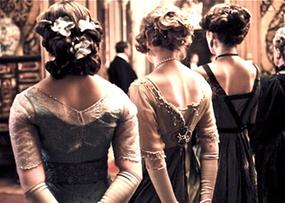Remember Lady Mary's alluring crimson silk dress? Lady Sybil's shockingly modern evening bloomers in sea green and blue organza? Poor Lady Edith's never very flattering high-waisted lace? The ladies of Downton always appear fashionably dressed; even the Dowager Countess, more modestly attired in black taffeta and net from cuff to neck, follows fashions, only hers tend to be from her glory days in about 1888.
Not quite the latest fashions, though the Crawford fortunes, having been invigorated by the Earl's fortunate marriage to the American daughter of Isodore Levinson, the dry goods millionaire, would make this possible. The aristocracy is very anxious about anything too new, and that goes for high fashion, recent titles, telephones and plumbing. Mama may occasionally go to Paris where the famous dressmaker, Poiret, is providing couture for the most elegant ladies of Europe, but the girls visit a local dressmaker.
 Even in midwinter Lady Mary looks relaxed in a watered silk evening dress, figure-hugging, sleeveless and all the better to show off her milky white skin before her arms plunge into her fine kid, elbow-length opera gloves. But even if you were close enough (and lucky enough) to dance with her, you would encounter a mystery. Neither Lady Mary nor any of the Crawfords (save, perhaps, granny) are wearing knitted chemises or lined liberty bodices. Nor are they swathed in woollen shawls, or knitted jackets trimmed with swansdown. Their noses are not red, nor do they sniff.
Even in midwinter Lady Mary looks relaxed in a watered silk evening dress, figure-hugging, sleeveless and all the better to show off her milky white skin before her arms plunge into her fine kid, elbow-length opera gloves. But even if you were close enough (and lucky enough) to dance with her, you would encounter a mystery. Neither Lady Mary nor any of the Crawfords (save, perhaps, granny) are wearing knitted chemises or lined liberty bodices. Nor are they swathed in woollen shawls, or knitted jackets trimmed with swansdown. Their noses are not red, nor do they sniff.
The truth is that large English country houses were (and are) freezing. Even now, when great houses have central heating, few old families turn it on except in exceptionally severe weather. In the early years of the 20th century, maids rose at 6 a.m. to light fires in all the reception rooms and, very quietly, in occupied bedrooms. But the huge rooms of most family seats had no further heating. Vast windows were often lined with whorls and stars of ice, winds whistled down long stone-flagged corridors, cold rose from vaulted cellars, drafts swirled upwards to glass cupolas in magnificent entrance halls. Every time a servant entered a room with a new tureen or chafing dish they brought with them the even icier blast from the hall. Even in summer a deep chill rose from the foundations; those who inherited ancient houses also inherited ancient damp.
The desirable blue blood may simply have been an effect of centuries of thermal endurance.
Unlike the leisurely and warm world of Downton, evenings could be hell in a great house and dinners a ritual that everyone longed to be over. The many courses served at meals in Edwardian England were offset by the calories required for the body to keep warm, and tragedies involving cold beauties, evening dresses and open fires were not unknown.
Most female diners looked like untidy parcels of velvet, fine wool, quilted satin and elderly fur. The lure of bed with a hot bedpan (or, yes, an illicit foreigner) was almost irresistible--though the lover might require considerable patience and skill as he unhooked, untied and unwrapped his prey.
But new and unashamed money soon bought new inventions and didn't see discomfort as somehow lower class, and central heating and piped hot water as scandalous luxury. The warm winds of change were on their way. --Elizabeth Speller, author of The Return of Captain John Emmett and The Strange Fate of Kitty Easton (Houghton Mifflin Harcourt; June 26, 2012)

